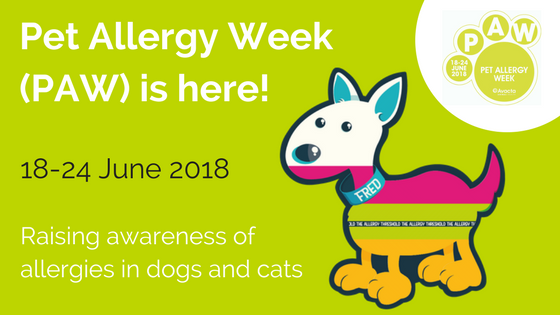
This week is Pet Allergy Week in conjunction with Avacta Animal Health. The theme for this year’s week is ‘the allergy threshold’.
WHAT THINGS CONTRIBUTE TO MAKING YOUR PET ITCH?
One way to explain the idea of the allergy threshold is by imagining your pet as an empty glass and all the things they are allergic to (known as allergens) as different liquids. Every time your pet comes in to contact with an allergen, the glass starts to fill up. This doesn’t cause any problems until you reach the brim of the glass, the ‘threshold’, at which point the liquid spills everywhere. In the same way, if your pet is exposed to lots of allergens, or too much of any one in particular, they ‘spill over’ the threshold and you see symptoms
SYMPTOMS OF ALLERGY
• Skin problems – itching, scratching, face rubbing, paw chewing, persistent licking and over-grooming
• Ear problems – swelling, itching and soreness
• Gastrointestinal problems – diarrhoea, vomiting, loss of appetite, weight problems
• Hair loss
In Fred’s case, he reacts to three different allergens (beef -pink, house dust mites – green and dandelions – yellow), but it only takes a combination of two of these to breach his threshold and for symptoms to occur. If he hasn’t been exposed to any of his allergens his ‘glass’ is empty. If he has been exposed just to dandelions and his threshold has not been reached, he will not have any of his allergy symptoms. However, if then exposed to both dandelions and house dust mites, the combination of these two allergens means he has reached his threshold and he will show symptoms. If exposed to all 3 allergens, even if one aspect is totally controlled e.g. he is fed no beef, he will still have some symptoms as it only takes two of his allergens for his ‘glass’ to overflow.
THE TREATMENT
The best way to help Fred long-term would be thinking about all three of his allergens. This would mean changing his diet and also reducing exposure to, and/or increasing his tolerance of, both dandelions and dust mites. The latter can be achieved with injections called immunotherapy. This approach will ‘stop the glass getting as full’ so help prevent symptoms occurring. For many animals, additional treatments will be needed to control the symptoms e.g. medications, medicated shampoos. This might be required all the time or just to cope with flare-ups when they happen.
SOME THINGS YOUR PET MAY BE ALLERGIC TO:
FOOD ALLERGENS e.g. Red meat, Poultry, Game, Fish, Cereals, Cow’s milk, Eggs
INDOOR ALLERGENS e.g. Storage mites, House dust mites, Dander, Mould, Fleas
OUTDOOR ALLERGENS e.g. Grasses, Weeds, Trees
“I SUSPECT MY PET IS ALLERGIC TO SOMETHING. WHAT DO I DO NOW?”
If you suspect that your pet has an allergy, the next step is to try and work out what might be causing it. Your vet will advise on whether allergy blood tests may aid in both the diagnosis and management of your pet’s condition. Any costs involved may even be covered by your pet insurance. The vet may need to rule out other problems e.g. parasites or skin infections and may advise a dietary trial, prior to doing allergy blood tests.
If you think your pet may have an allergy, we would advise booking an appointment with one of our vets. You can call us on 01803 606059 (Torquay) or 01803 843836 (Paignton) or book online.

